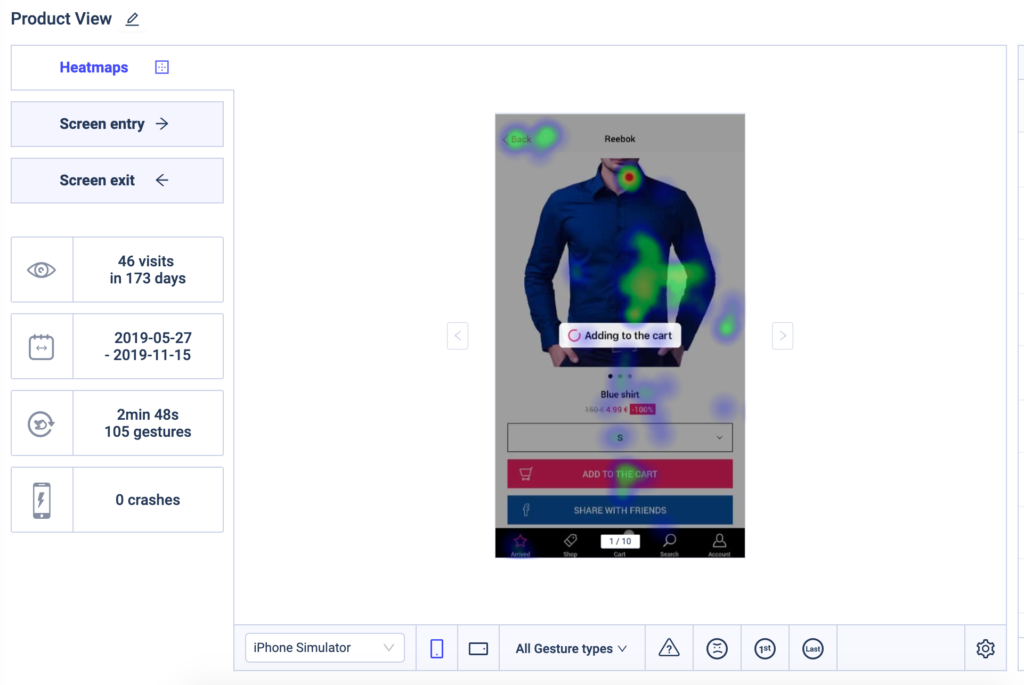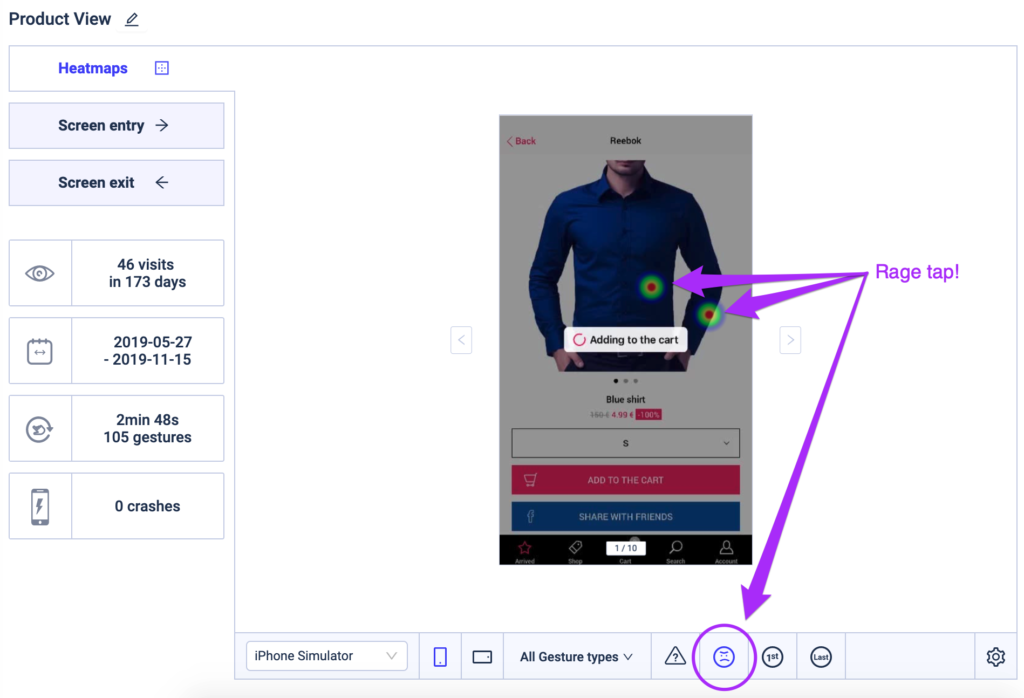Mobile app marketing is a data-driven business. Yet, the age-old challenge of insufficient data has been preventing us from unlocking the full potential of what data can offer in mobile marketing. More importantly, as app marketing is essentially product marketing, we usually have to rely on the data from product analytics to generate insights for marketing. After all, how can you showcase your app if you don’t know what about it is so special to the users?
In this article, we will outline a few ways in which we can use product analytics to serve mobile marketing purposes. More specifically, we’ll highlight on:
- The role of qualitative data from product/app analytics as the missing piece of the data puzzle in marketing
- The technological possibilities of qualitative app analytics tools that can help (with the case of UXCam as our vendor of choice)
- Typical forms qualitative data-driven app marketing strategies
Customlytics, App Marketing & Data
Sadly, several data challenges are stopping us from truly understanding the aspects of product that could best serve as resources for marketing.
For one, we work the most with quantitative data, which constantly faces the problems of discrepancies, fraud, inconsistencies, and many more. These can easily make the numbers you’re looking at unreliable or misleading.
For another, we rarely ever speak or think about qualitative data, such as users’ behaviors, attitudes, and so on. This is due to many reasons, but mainly because we don’t have a reliable technical or technological means of collecting and analyzing such data.
Finally, even with the means to make product analytics, many marketers still perceive product and marketing separately. Consequently, they don’t pay attention to how product insights could inform marketing decisions.
As marketers sharing the same challenges, we at Customlytics have been scratching our heads in finding solutions for them. For quantitative data, we could depend on reputable vendors like Amplitude, Mixpanel, or the free offering of Google Firebase. We also have our own Data Warehousing and Business Intelligence (BI) capabilities, which amplify the support from these quantitative app analytics powerhouses. However, while they do answer the “What” and “Who” pretty well, we often look for the “Why” and “How” as well. There are indicators that can’t be measured with numbers, such as the emotions a user feels right before making a purchase or exiting an app, or the confusing going on in their mind during a session with poor UX/UI. Our marketing strategies demand to have both qualitative and quantitative data, so how do we deal with this?

UXCam, Product Analytics & Qualitative Data
Doing product analytics with qualitative data, or qualitative product/app analytics is rarely used largely due to an absence of relevant technologies. Even when you find one, you can’t even be sure yet if you could trust it. We used to be able to rely on Appsee, which was one of the best options available in the market. However, after they sold their service, we had to start finding an alternative all over again – until we found UXCam.UXCam is the market leader for mobile app experience analytics:

With UXCam, you’re able to understand the big picture of your app. Based on these findings, you can drill down further to specific flows, e.g. interesting funnels or important events. Finally, you can take the last step and analyze individual user journeys.
This allows you to get a full 360-degree view on your user’s experience – by just using one solution.
UXCam was built with privacy by design. It’s GDPR-compliant architecture is accompanied by fully encrypted and tested security that keeps your data safe. This is proven by the fact that even financial institutions and companies like NBC, Nissan and Costa Coffee trust UXCam. Overall, 10,000+ mobile appexperts, including us at Customlytics, use UXCam.
Most importantly, these services are not only important for product features and UX/UI improvements. By learning more about user behaviors, you can inform your marketing strategies as well. From in-app marketing activities (like mobile CRM) to performance marketing and app store optimization (ASO), as long as you can use qualitative data, you can use UXCam or an equivalent tool to support it. Let’s explore what it’s capable of!
1. User flow
The first step towards understanding your app (in order to market it) is to learn how it works. And the best way to know how it works is to map out the user journey, that is, what can users interact with inside the app. With the help of a qualitative app analytics tool like UXCam, you can conjure a user flow from the app that represents what users see, tap on, zoom in, swipe off, and so on. It also shows how popular each screen is, based on the thickness that represents how many % of users spend time there, and how the screens are sequenced, based on how different screens are connected in chronological order.

2. Heat map
While the user flow provides a top-down high-level overview on the trends of user journeys in the app, it doesn’t show you what they do in each milestone (screen) specifically. Sometimes you need to see which buttons most users tap on, which contents they interact with the most, and so on. This is where UXCam’s heat map comes in.

In a nutshell, the heat map shows the extent to which each specific element on a screen of an app receives are touched by users. The heat scale represents the interaction popularity, e.g. higher heat (red) means more taps and/or from more users. It hints at why users tend to interact with which milestones (e.g. because there’s something valuable or interesting to touch on).
In addition, sometimes users get so frustrated at a screen that they begin “rage tapping”, or angrily and sometimes even violently and rapidly tapping on certain points on the screen. They either want the app to load faster (e.g. during a frozen frame) or to stop it from loading further (e.g. after mistakenly tapping on an unwanted button). These scenarios reflect what users don’t like, and apart from the attempts to improve the product itself, marketing efforts should also mind them.

3. Session recordings
Sometimes you’ll start wondering what exactly happens to users as they use your app. Static images just aren’t enough anymore – there are complexities that you just need to see things through users’ eyes to witness and solve. Wouldn’t you wish for a little sneak peek into what exactly was shown and touched by the users?
With such tools as UXCam, this is totally possible. You have the ability to legally replay and watch sessions of user interactions in your app after they are recorded directly on their devices (of course, it will follow procedures that comply with GDPR).
The advantages are plenty.
- You get to feel more dynamics around each recorded user interaction thanks to the nature of video motions.
- It provides further contexts for what happens before important events as well as after, in a sequence.
- Finally, it reveals the complexities such as discontinuously repeated actions and pauses that may correlate to things users want to stop and stare at.
In any case, it’s the significantly higher level of detail that makes it invaluable. It unlocks a unique opportunity to take a deep dive into the complex user journey aspects that static heat maps or user flows can’t access.

Qualitative App Analytics & App Marketing
1. Performance marketing
On top of a mobile app marketing funnel, there’s user acquisition (UA). We have dedicated a whole chapter in our Mobile Developer’s Guide on this topic. One of the major goals of this is to increase the awareness of users about your app, or improving its visibility so more of them will see and know about it. You can either do it with advertising (paid UA) or without (organic UA). While organic UA offers great long-term impact and efficiency, paid efforts tend to promise massive coverage to make sure users notice your app at scale.
As mobile marketers, our go-to method is using performance marketing to reach such goals. As the name suggests, this involves performance-based paid marketing (advertising) efforts. The goal is to run trackable, and thus optimizable, ad campaigns that reach millions of users without burning millions of dollars. The effectiveness of each campaign depends on how well the messaging persuades users, textually and visually, to visit their App Store Product Page (iOS) or Google Play Store Listing (Android) and install it. Sometimes, a retargeting campaign may also be employed to bring back churned users into the app.
In either case, you will need correct segmentation to make sure you target the right audience. In addition, you will need to make sure the visual assets as well as the copywriting are relevant to them. More importantly, the data that helps you determine them is only reliable coming from your app – more precisely, from the current, real users of the app.
For segmentation, it’s important that you aren’t primed by the subjective views on who your users are. User archetypes, personas and similar forms of such reductionist practices won’t answer the technical questions of “What makes users download your app?”. Anything you think you know about the users is most likely based on assumptions, not data, and it isn’t good enough.
To gain data, we would use a tool like UXCam to record and analyze videos of user sessions. We can quickly eliminate most of the guesswork because you see a reality of what users pay attention to (e.g. they stop while browsing to see something interesting), what they ignore (e.g. keep scrolling without taking any action), what intrigues them (e.g. zoom in on a small section on the screen), and so on. This is beyond interest and intent-based segmentation. This could help you segment users based on their actual in-app interactions.

For the relevance of ad assets, we can use UXCam’s heat map to reveal what popular features and contents to highlight on, as well as what unpopular elements to avoid mentioning or showing. Not only will it help you identify opportunities for ad optimization, but it could also help you set better priorities in performance marketing.

2. App Store Optimization
In our holistic mobile marketing funnel, app store optimization is usually coupled with performance marketing. For one, all mobile traffic is supposed to lead to the App/Play store listing of your app. Unless deeplinking is in place and users have already installed (and/or also uninstalled) the app, users are redirected into an app store to install it. As soon as this happens, performance marketing’s mission is as good as accomplished, as users’ install decisions will mostly happen in the app stores. More importantly, these decisions can be influenced by a wide variety of app store assets, both textual and visual, and app store optimization (ASO) has the power to maximize such influence.
In our daily work at Customlytics, perhaps the most popular app store asset is the set of screenshots. In general, app store screenshots are a gallery of images about (and showcasing) your app to impress and convince users. Similar to the ad assets, this requires a thorough understanding of the users and what may be deemed relevant or irrelevant to them and their install decisions. There could be AB tests to find out, there could also be assumptions and superficial beliefs, which are fine, except they aren’t good enough. Things could be easier, faster and more accurate with data from product analytics.
Remember UXCam’s user flow we mentioned above? It also shows which stages or milestones in a flow are more popular than the others. This will give you both the sense of relevance based on real users’ interactions and the chronological order of events that could very well define the order of your app store screenshots when you show multiple units at once. As well as this, you can use the heat map to figure out what’s so special about each milestone and use the same thing to show to new users and get more installs.

In a recent ASO project, we applied similar logics with similar data to figure out an ideal screenshots order for CodeCheck, an app from one of our clients. The results were positive and we managed to help them achieve a positive conversion rate uplift.

Screenshots aren’t the only thing you need to optimize in ASO for better conversions. There are other assets that could benefit as well. For instance, producing a video could get so much easier now that you can watch recordings of real users’ in-app sessions to get inspiration. The possibilities are limitless, so if you are ever in doubt, don’t hesitate to contact us to discuss plans to exploit product analytics for marketing purposes, as well as our partner UXCam to learn more about the full extent of their technology.
3. CRM, Retention & Engagement
Once the UA phase is done, your user base should grow strongly. But how do you keep them? The answer is always CRM, which stands for Customer Relationship Management. The goal of CRM is twofold: to retain users in the app, then keep them actively engaged with it – hence, retention and engagement. At Customlytics, we split the topic into 2 sides:
- The technological side that is part of the larger mobile marketing infrastructure, where tools are integrated and the backend setups are structured
- The campaign side where actual campaigns can be run and automated by this infrastructure.
Because we are dealing with the data needed for better marketing campaign optimization, we’ll be focusing on the campaign side this time.
For a retention campaign to work, one of the very first things we need to do is map out an event tracking concept. This is where all relevant conversion events (after app installs) are mapped, analyzed and used to configure the triggers for in-app messages, push notifications and other CRM messaging methods. However, even with a full list of detailed events and their relevant information (event attributes), it’s just the first step towards CRM success, you need to figure out which events to focus on, based on what attributes, how they should be prioritized, and why.
Such questions can be answered partly or fully with the help of UXCam. For example, with their Reverse Flow feature, you can see the last milestones or in-app screens a user visits right before exiting, and what they had interacted with prior to that, like this:

As seen in the sample flow, many users tend to leave the Product Overview section for their User Profile page then just quit – no purchase is made, or conversion event occurs. As CRM’s purpose is to keep users in there, preventing their exits is a main objective, and with this kind of data, you can already decide something (e.g. an in-app message) needs to happen on the User Profile page for those who return from the Product Overview section to keep them from quitting.
Again, this is but one of many ways to make use of UXCam and equivalent tools for mobile CRM. As long as you have enough data, which you will, anything is possible.
Conclusion
Above are just a few simple use cases of a qualitative app analytics tool in mobile app marketing. Across the marketing funnel, there are always black spots of insufficient or missing data that could be remedied with insights from tools such as UXCam. From user behaviors and segmentation to creative production and validation, these tools could fit in mobile app marketing strategies perfectly if you let them do their job.
In the end, what they contribute is the major missing piece of the data puzzle that is qualitative data. The tech, the infrastructure, and the KPIs are, without a doubt, the core of data-driven app marketing, and that’s what we rely on every day. But the extra piece of qualitative data sometimes just makes things so much easier and more accurate for us, especially when we deal with complex UX and unclear user intents.We have outlined some suggestions for qualitative data-driven marketing strategies with UXCam, from performance marketing and app store optimization to mobile CRM and retention campaigns. Other topics, such as monetization, could benefit as well (e.g. learning which price plans are popular among existing users with UXCam to inform a new pricing strategy). We hope they can inspire you to go above and beyond in getting more data for marketing. Of course, we’re always happy to help if you need support in app marketing setups and campaign management. Finally, we’re sure our friends at UXCam will be glad to show you more about their tool as well.







